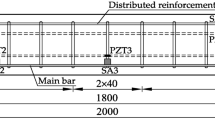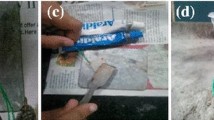Abstract
The civil infrastructures constructed using self-compacting concrete (SCC) reinforced with fiber-reinforced polymer (FRP) bars are advocated for engineering applications due to corrosion resistance and environmental-friendly performance. The bond behavior between FRP reinforcement and SCC is a significant factor affecting the serviceability and failure mechanism of this composite structure. However, it is hard to identify the damage mechanism and failure mode of the interface bond using the traditional test methods. Therefore, an effective monitoring method of interface damage using piezoceramic transducers is proposed in this paper. A series of pull-out tests were performed, and the test variables involved concrete materials and reinforcing bar types. A lead zirconate titanate (PZT) patch transducer acting as an actuator was bonded on the outer surface of reinforcing bars, and a piezoceramic smart aggregate transducer acting as a sensor was embedded in the SCC. A wavelet energy ratio index (WERI) is proposed to identify the damage mechanism of interface between reinforcing bars and SCC. The experimental test results reveal that the damage mechanism and failure mode of the bond between different reinforcing bars and concrete materials can be identified effectively and the peak of bond stress can be captured accurately by using WERI values.
Graphic abstract
















Similar content being viewed by others
References
Worrell E, Price L, Martin N, Hendriks C, et al. Carbon dioxide emissions from the global cement industry1. Annu Rev Energy Environ. 2003;26(1):303–29.
Chen YY, Tuan BLA, Hwang CL. Effect of paste amount on the properties of self-consolidating concrete containing fly ash and slag. Constr Build Mater. 2013;47:340–6.
Nagaratnam BH, Faheem A, Rahman ME, Mannan MA, et al. Mechanical and durability properties of medium strength self-compacting concrete with high-volume fly ash and blended aggregates. Period Polytech Civil Eng. 2015;59(2):155–64.
Zheng Y, Taylor SE, Sonebi M, Robinson D (2016) The influence of arching action on BFRP reinforced SCC deck slabs in Thompson bridge. In Proceedings of the 24th Australasian conference on the mechanics of structures and materials, Perth, Australia, 6–9 December.
Zhou LZ, Zheng Y, Taylor SE. Finite-element investigation of the structural behavior of basalt fiber reinforced polymer (BFRP): reinforced self-compacting concrete (SCC) decks slabs in Thompson bridge. Polymers. 2018;10(6):678.
Bossio A, Monetta T, Bellucci F, Lignola GP, et al. Modeling of concrete cracking due to corrosion process of reinforcement bars. Cem Concr Res. 2015;71:78–92.
Li W, Ho SCM, Song G. Corrosion detection of steel reinforced concrete using combined carbon fiber and fiber Bragg grating active thermal probe. Smart Mater Struct. 2016;25(4):045017.
Huo L, Li C, Jiang T, Li HN. Feasibility study of steel bar corrosion monitoring using a piezoceramic transducer enabled time reversal method. Appl Sci. 2018;8(11):2304.
Zheng Y, Zhou LZ, Xia LP, et al. Investigation of the behaviour of SCC bridge deck slabs reinforced with BFRP bars under concentrated loads. Eng Struct. 2018;171:500–15.
Lu XZ, Chen JF, Ye LP, Teng JG, et al. RC beams shear-strengthened with FRP: stress distributions in the FRP reinforcement. Constr Build Mater. 2009;23(4):1544–54.
Zheng Y, Sun C, Deng T, Yang JB, et al. Arching action contribution to punching failure of GFRP-reinforced concrete bridge deck slabs. Arab J Sci Eng. 2014;39:8609–25.
Taylor SE, Zheng Y, Robinson D, Sonebi M, et al. Application and structural health monitoring of self-compacting concrete used in a BFRP reinforced concrete slab in Thompson’s bridge. Dublin: Civil Engineering Research in Ireland; 2016.
Gonilha José A, Correia João R, Branco FA. Dynamic response under pedestrian load of a GFRP–SFRSCC hybrid footbridge prototype: experimental tests and numerical simulation. Compos Struct. 2013;95:453–63.
Gu X, Yu B, Wu M. Experimental study of the bond performance and mechanical response of GFRP reinforced concrete. Constr Build Mater. 2016;114:407–15.
Mazaheripour H, Barros JAO, Sena-Cruz JM, Martinelli E. Experimental study on bond performance of GFRP bars in self-compacting steel fiber reinforced concrete. Compos Struct. 2013;95(95):202–12.
Tighiouart B, Benmokrane B, Gao D. Investigation of bond in concrete member with fibre reinforced polymer (FRP) bars. Constr Build Mater. 1998;12(8):453–62.
Benmokrane B, Tighiouart B, Chaallal O. Bond strength and load distribution of composite GFRP reinforcing bars in concrete. ACI Mater J. 1996;93(3):246–53.
Achillides Z, Pilakoutas K. Bond behavior of fiber reinforced polymer bars under direct pullout conditions. J Compos Constr. 2004;8(2):173–81.
Al-Mahmoud F, Castel A, François R, Tourneur C. Effect of surface pre-conditioning on bond of carbon fibre reinforced polymer rods to concrete. Cement Concr Compos. 2007;29(9):677–89.
Baena M, Torres L, Turon A, Barris C. Experimental study of bond behaviour between concrete and FRP bars using a pull-out test. Compos B Eng. 2009;40(8):784–97.
Helincks P, Boel V, De Corte W, De Schutter G, et al. Structural behaviour of powder-type self-compacting concrete: bond performance and shear capacity. Eng Struct. 2013;48:121–32.
Pop I, Schutter GD, Desnerck P, Onet T. Bond between powder type self-compacting concrete and steel reinforcement. Constr Build Mater. 2013;41:824–33.
Golafshani EM, Rahai A, Sebt MH. Bond behavior of steel and GFRP bars in self-compacting concrete. Constr Build Mater. 2014;61:230–40.
Xu K, Deng Q, Cai L, Ho S, et al. Damage detection of a concrete column subject to blast loads using embedded piezoceramic transducers. Sensors. 2018;18(5):1377.
Wang F, Ho S, Huo L, Song G. A novel fractal contact-electromechanical impedance model for quantitative monitoring of bolted joint looseness. IEEE Access. 2018;6:40212–20.
Huo L, Li X, Chen D, Li H, et al. Identification of the impact direction using the beat signals detected by piezoceramic sensors. Smart Mater Struct. 2017;26(8):085020.
Wang G. Analysis of bimorph piezoelectric beam energy harvesters using Timoshenko and Euler–Bernoulli beam theory. J Intell Mater Syst Struct. 2013;24(2):226–39.
Huo L, Chen D, Kong Q, Li H, et al. Smart washer: a piezoceramic-based transducer to monitor looseness of bolted connection. Smart Mater Struct. 2017;26(2):025033.
Song G, Gu H, Mo YL. Smart aggregates: multi-functional sensors for concrete structures: a tutorial and a review. Smart Mater Struct. 2008;17(3):033001.
Xu J, Wang C, Li H, Zhang C, et al. Health monitoring of bolted spherical joint connection based on active sensing technique using piezoceramic transducers. Sensors. 2018;18(6):1727.
Wang B, Huo L, Chen D, Li W, et al. Impedance-based pre-stress monitoring of rock bolts using a piezoceramic-based smart washer—a feasibility study. Sensors. 2017;17(02):0250.
Tsangouri E, Karaiskos G, Aggelis DG, Deraemaeker A, et al. Crack sealing and damage recovery monitoring of a concrete healing system using embedded piezoelectric transducers. Structural Health Monitoring. 2015;14(5):462–74.
Zou D, Liu T, Liang C, Huang Y, et al. An experimental investigation on the health monitoring of concrete structures using piezoelectric transducers at various environmental temperatures. J Intell Mater Syst Struct. 2015;26(8):1028–34.
Zeng L, Parvasi SM, Kong Q, Huo L, et al. Bond slip detection of concrete-encased composite structure using shear wave based active sensing approach. Smart Mater Struct. 2015;24(12):125026.
Xu B, Li B, Song G. Active debonding detection for large rectangular CFSTs based on wavelet packet energy spectrum with piezoceramics. J Struct Eng. 2013;139(9):1435–43.
Qin F, Kong Q, Li Mo, Mo YL, et al. Bond slip detection of steel plate and concrete beams using smart aggregates. Smart Mater Struct. 2015;24(11):115039.
Xu K, Ren C, Deng Q, Jin Q, et al. Real-time monitoring of bond slip between GFRP bar and concrete structure using piezoceramic transducer-enabled active sensing. Sensors. 2018;18(8):2653.
Jiang T, Kong Q, Patil D, Luo Z, et al. Detection of debonding between fiber reinforced polymer bar and concrete structure using piezoceramic transducers and wavelet packet analysis. IEEE Sens J. 2017;17(7):1992–8.
Dumoulin C, Karaiskos G, Sener JY, Deraemaeker A. Online monitoring of cracking in concrete structures using embedded piezoelectric transducers. Smart Mater Struct. 2014;23(11):115016.
Zou D, Liu T, Huang Y, Zhang F, et al. Feasibility of water seepage monitoring in concrete with embedded smart aggregates by P-wave travel time measurement. Smart Mater Struct. 2014;23(6):067003.
Feng Q, Kong Q, Song G. Damage detection of concrete piles subject to typical damage types based on stress wave measurement using embedded smart aggregates transducers. Measurement. 2016;19:425.
Zhang J, Xu J, Guan W, Du G. Damage detection of concrete-filled square steel tube (CFSST) column joints under cyclic loading using piezoceramic transducers. Sensors. 2018;18(10):3266.
Moslehy Y, Gu H, Belarbi A, Mo YL, et al. Smart aggregate based damage detection of circular RC columns under cyclic combined loading. Smart Mater Struct. 2010;19(6):065021.
Xu B, Zhang T, Song G, Gu H. Active interface debonding detection of a concrete-filled steel tube with piezoelectric technologies using wavelet packet analysis. Mech Syst Signal Process. 2013;36(1):7–17.
Zhou L, Zheng Y, Song G, Chen D, et al. Identification of the structural damage mechanism of BFRP bars reinforced concrete beams using smart transducers based on time reversal method. Constr Build Mater. 2019;220:615–27.
Song G, Gu H, Mo YL, Hsu TTC, et al. Concrete structural health monitoring using embedded piezoceramic transducers. Smart Mater Struct. 2007;16(4):959–68.
Feng Q, Cui J, Wang Q, Fan S, et al. A feasibility study on real-time evaluation of concrete surface crack repairing using embedded piezoceramic transducers. Measurement. 2017;122:591.
Zeng T, Huo L, Gao W, Li H, et al. Modelling of attenuation of stress wave in concrete based on Rayleigh damping model using time-reversal and PZT transducers. Smart Mater Struct. 2017;26(10):105030.
Yan F, Lin Z, Yang M. Bond mechanism and bond strength of GFRP bars to concrete: a review. Compos B Eng. 2016;98:56–69.
Sabau M, Pop I, Onet T. Experimental study on local bond stress-slip relationship in self-compacting concrete. Mater Struct. 2016;49(9):3693–711.
Bompa DV, Elghazouli AY. Bond-slip response of deformed bars in rubberised concrete. Constr Build Mater. 2017;154:884–98.
Muñoz, M.B. (2010). Study of bond behaviour between FRP reinforcement and concrete. Doctoral dissertation, Universitat de Girona.
Efnarc F. Specification and guidelines for self-compacting concrete. English ed. Norfolk: European Federation for Specialist Construction Chemicals and Concrete Systems; 2002.
ACI 440.3R-04. Guide test methods for fiber-reinforced polymers (FRPs) for reinforcing or strengthening concrete structures, ACI Committee 440. Farmington Hills: American Concrete Institute; 2004.
Zhou L, Zheng Y, Luo Y, Zhan F, Sun C. Investigation of material properties of self-compacting concrete with high mixed volume of fly-ash. Concrete. 2017;11:63–73 (In Chinese).
Planès T, Larose E. A review of ultrasonic coda wave interferometry in concrete. Cem Concr Res. 2013;53(Complete):248–55.
Zheng Y, Chen D, Zhou L, Huo L, Ma H, Song G. Evaluation of the effect of fly ash on hydration characterization in self-compacting concrete (SCC) at very early ages using piezoceramic transducers. Sensors. 2018;18(8):2489.
CSA S806-02. Design and construction of building components with fibre-reinforced polymers. Ontario: Canadian Standards Association; 2002.
Di B, Wang J, Li H, Zheng J, Zheng Y, Song G. Investigation of bonding behavior of FRP and steel bars in self-compacting concrete structures using acoustic emission method. Sensors. 2019;19(1):159–73.
Rolland A, Quiertant M, Khadour A, Chataigner S, et al. Experimental investigations on the bond behavior between concrete and FRP reinforcing bars. Constr Build Mater. 2018;173:136–48.
Acknowledgements
This work was supported by the Natural Science Foundation of China (51678149), the Guangdong Science and Technology Planning (2016A010103045) and the Key Research Project by Department of Education of Guangdong Province, China (2018KZDXM068). The authors are sincerely grateful for these financial supports.
Author information
Authors and Affiliations
Corresponding authors
Additional information
Publisher’s Note
Springer Nature remains neutral with regard to jurisdictional claims in published maps and institutional affiliations.
Rights and permissions
About this article
Cite this article
Zhou, L., Zheng, Y., li, H. et al. Identification of bond behavior between FRP/steel bars and self-compacting concrete using piezoceramic transducers based on wavelet energy analysis. Archiv.Civ.Mech.Eng 20, 37 (2020). https://doi.org/10.1007/s43452-020-00041-1
Received:
Revised:
Accepted:
Published:
DOI: https://doi.org/10.1007/s43452-020-00041-1




